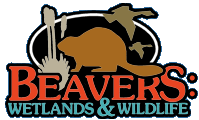WATCHABLE WILDLIFE
Beaver ponds are great places for “watchable wildlife”.
Not only are the beavers fascinating to observe as they forage, groom and build, but their ponds are magnets for other wild creatures. Try taking a walk to a beaver pond an hour or two before sunset, to relax and enjoy the variety of birds and wild animals. If the area is posted to protect the wildlife, consider leaving some cracked corn at the shoreline to attract birds and/or throwing a few apple halves in the water for the beavers. Don’t try to hide behind a bush or tree, as the beavers will know you’re there, but stay about 15 feet from the shore and talk quietly.
At first, you may only see – and hear – some loud tail slaps, but if pond sitting becomes a habit, the wild residents will begin to accept you. Watching the beavers and their interactions with other animals is fun and educational for children, and can become an absorbing, lifelong hobby for adults. What you see depends upon the location of the pond, and here are some photos from the Northeast. If you spend enough time at a beaver pond, eventually you will meet almost all of your wild neighbors.
Birdwatchers
Birdwatchers know that beaver ponds and wetlands are excellent places to add to their life list. Even more songbirds thrive along the watery edge habitat than do ducks, grebes and herons. Catbirds, bluebirds and phoebes often nest in trees ringing the ponds. Those who wait quietly may be treated to the sight of a wood duck family and a green heron or great blue heron fishing.
Land Animals
Many land animals, such as deer and, more rarely, black bears, come to the shore to forage and drink. Seeing a deer swimming with just the head above water is a treat. If a doe becomes used to you, she may eventually bring along her fawns.
Frogs and Toads
People who enjoy frogs and toads (many of these amphibians are endangered worldwide) will have a feast for their senses, especially in the spring when the mating critters are in full song. The singers may include strumming green frogs (occasionally a bright blue one appears), trilling toads, shrill peepers and booming bull frogs. Both painted and snapping turtles are quite common. The big snappers like apples as much as beavers do and may attempt to snatch one from a beaver’s paws. But even a big turtle is no match for a beaver, and a yearling can dunk them.
BEAVERS BECOME FRIENDLY
Once the beavers become friendly, you can watch their interactions with each other and with other wildlife. They are peaceful animals, but may react to overly aggressive Canada goose parents by diving under them.
Muskrats, Otters and Minks
Muskrats eat the same food as beavers, and you may see one swim by carrying a bunch of marsh grass so big that only a wiggling tail is visible. Otters and minks often fish in beaver ponds (beavers do not eat fish). It’s amusing to see an otter stare at you with that periscope-like neck above the water or to watch a mink repeatedly shake the water from its fur each time it climbs on a beaver cache of branches—only to dive right back in again.
OWLS, HAWKS AND EAGLES
While waiting for the beavers to appear, you may see a hunting barred owl, marsh hawk or even a bald eagle. Cloud formations can be intriguing, and don’t miss the sunset! Every time at a beaver pond is different, and that’s part of the fun.


GREEN FROG
Green frogs are often seen at the edge of a pond, but more often heard. Their call sounds like a banjo string being plucked.

BLACK BEAR
Black bears seem afraid of everything including snapping turtles. They will climb a tree for safety!

RACCOON
Raccoons are may be seen foraging for food along the edge of the pond. They are so tactile. They seem to feel everything they find before they put it in their mouth.

WOOD DUCK PAIR
The wood duck population has recovered along with the increase in population of beavers and wetlands. What a magnificent looking bird! The male is behind the female.

MUSKRAT
Wherever there are beavers, there also tend to be muskrats. They eat similar food yet coexist well as seen in the photo to the right

BEAVER & MUSKRAT COEXIST
Beaver and muskrat eating in harmony. You could almost mistake the muskrat for a baby beaver.

PORCUPINE
Porcupines can be seen in trees, and go way out on a limb to eat the leaves and tender bark. This one is climbing an apple tree.

DEER
If you are lucky, you will see a mother deer with her fawn. Notice the fawn has lost most of its spots.They come to the pond for a drink and to forage.

DEER & GEESE FAMILY
A young deer watches a Canada Geese family. These may be the first goslings she has seen.
